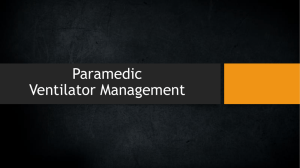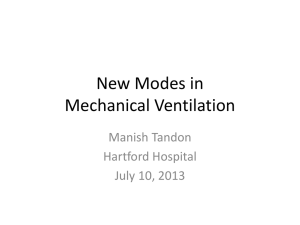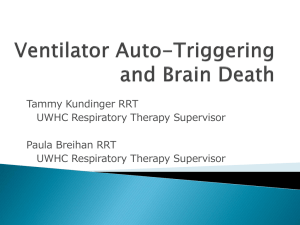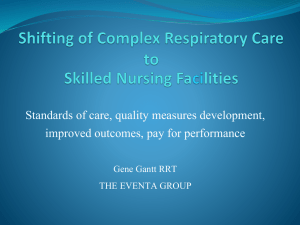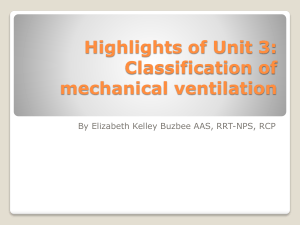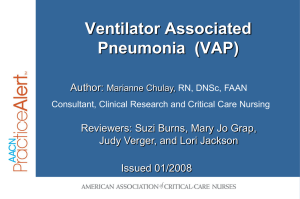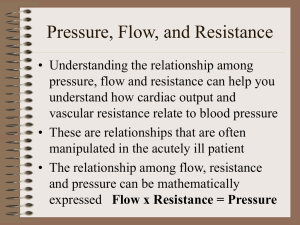nursing-roles-in-pre..
advertisement
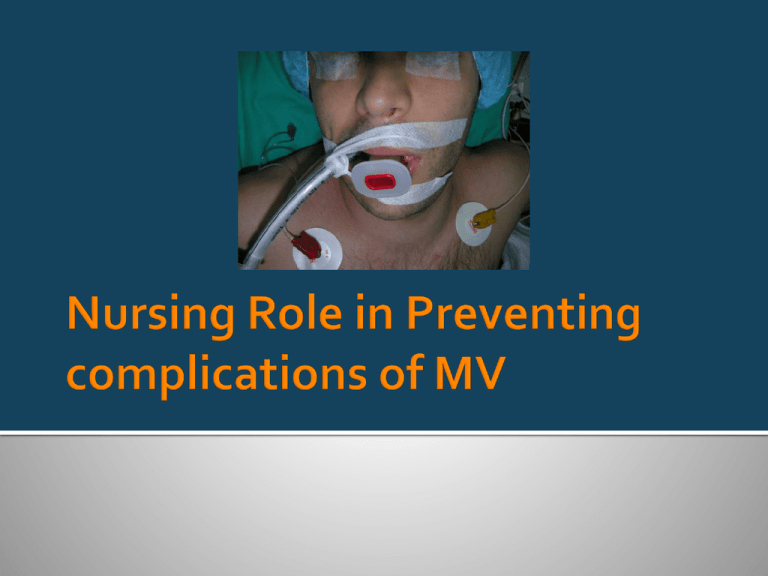
Airway complications Hemodynamic disturbances Ventilator associated lung injury: VILI Oxygen toxicity Ventilator associated pneumonia Pulmonary emboli Patient ventilator asynchrony Sleep disturbance Airway complications Hemodynamic disturbances Ventilator associated lung injury: VILI Oxygen toxicity Ventilator associated pneumonia Pulmonary emboli Patient ventilator asynchrony Sleep disturbance Avulsion of skin due to adhesive tape Trauma to the lips and cheeks from tube ties Pressure ulcers to the palate and oropharynx Injuries to the entrapped tongue Perioral herpes 3-4 cm Secure ET tube in place, note the number Sedate patient with appropriate MAAS Avoid accidental, or self extubation Laceration and hematoma in the left vocal fold during direct laryngoscopy. Exam performed with rigid telescope Bilateral intubation granulomas inserted in the vocal apophasis. Exam performed with rigid telescope. Ulcerated lesion in the posterior glottic commissure soon after extubation. Exam performed with rigid telescope. diffuse posterior erythema, edema and piled-up mucosa of inter-arytenoid area Risk of mechanical complications Risk of aspiration Prince J S et al. Radiographics 2002;22:S215-S230 Tracheal stenosis (exam performed with flexible nasofibroscope) Glottic stenosis (exam performed with rigid telescope). Tracheal collapse of more than 50% during expiration is diagnostic of tracheomalacia The AnapnoGuard system detects air leakage from the lungs by measuring the CO2 level above the cuff. Detection of high CO2 levels above the cuff represents leakage Air inflation of the tube cuff until the airflow heard escaping around the cuff during positive pressure breath ceases. Place a stethoscope over larynx. Indirectly assesses inflation of cuff. Slowly withdraw air (in 0.1-mL increments) until a small leak is heard on inspiration. Remove syringe tip, check inflation of pilot balloon Airway complications Hemodynamic disturbances Ventilator associated lung injury: VILI Oxygen toxicity Ventilator associated pneumonia Pulmonary emboli Patient ventilator asynchrony Sleep disturbance 64 year old male with history of COPD who presented with severe respiratory distress and required to be intubated and placed on CMV, VT of 650 ml and a rate of 24/min. Immediately post intubation, his systolic blood pressure dropped from 132 mm Hg to 73 mm Hg. 120 5 3 0 -3 10 0 110 5 3 0 -3 8 0 No effect in Normal individual with PEEP less than 10 cmH2O Major effect in patients with Dynamic Hyperinflation such as asthma and COPD, and in pre-existing pulmonary hypertension Small changes in PVR can cause considerable hemodynamic compromise secondary to acute increase in PVR Avoid air trapping in these patients Decreased cardiac output, decreased venous return Observe for: ▪ ▪ ▪ ▪ ▪ ▪ Decreased BP Restlessness, decreased LOC Decreased urine output Decreased peripheral pulses Slow capillary refill Increasing Tachycardia Airway complications Hemodynamic disturbances Ventilator associated lung injury: VILI Oxygen toxicity Ventilator associated pneumonia Pulmonary emboli Patient ventilator asynchrony Sleep disturbance Volutrauma • Overdistention Atelectetrauma • Repeated recruitment and collapse Bio trauma • Inflammatory mediators Barotrauma • High-pressure induced lung damage Oxygen toxic effect • FiO2 Atelectrauma: Repetitive alveolar collapse and reopening of the underrecruited alveoli Volutrauma: Over-distension of normally aerated alveoli due to excessive volume delivery Biotrauma Cytokines, complement, prostanoids, leukotrienes, O2- Proteases *Dreyfuss: J Appl Physiol 1992 Pinsp = 40 mbar Airway Trauma “Stretch” “Shear” Overdistension Edema fluid accumulation Surfactant degradation High oxygen exposure Mechanical disruption Zone of Overdistention Injury “Safe” Window Derecruitment, Atelectasis Repeated closure / re-expansion Stimulation inflammatory response Inhibition surfactant Local hypoxemia Compensatory overexpansion Volume Zone of Derecruitment and Atelectasis Injury Pressure Diseased Lungs Do Not Fully Collapse, Despite Tension Pneumothorax And they cannot always be fully “opened” Dimensions of a fully Collapsed Normal Lung Airway complications Hemodynamic disturbances Ventilator associated lung injury: VILI Oxygen toxicity Ventilator associated pneumonia Pulmonary emboli Patient ventilator asynchrony Sleep disturbance Alveolar pressure PAO2 PACO2 PAH2O PAN2 Absorptive atelectasis O2/N2 = 21/79 >>>>>> 50/50 Accentuation of hypercapnia Chronic respiratory failure: PCO2 with PO2 Carbon dioxide Damage to airways Bronchopulmonary dysplasia Oxygen Diffuse alveolar damage Water vapour Nitrogen PEEP Alveolar recruitment maneuvers Alternative modes of ventilation Inverse-ratio , APRV, HFV, ….. Inhaled nitric oxide (iNO) Extracorporeal membrane oxygenation (ECMO) Diuresis if pulmonary edema is possible Bronchopulmonary hygiene if secretions are prominent Augmentation of antioxidants?? Airway complications Hemodynamic disturbances Ventilator associated lung injury: VILI Oxygen toxicity Ventilator associated pneumonia Pulmonary emboli Patient ventilator asynchrony Sleep disturbance VAP – ventilator associated pneumonia >48 hours on vent Combination of: ▪ CXR changes ▪ Sputum changes ▪ Fever, ↑ WBC ▪ positive sputum culture Occurs secondary to micro-aspiration of upper airway secretions No 1 risk factor is endotracheal intubation Factors that related to cross contamination: Poor adherence to infection control standards Factors that enhance colonization of the oropharynx &/or stomach: Poor oral hygiene Conditions favoring aspiration into the respiratory tract or reflux from GI tract: Supine position NGT placement Re-Intubation and self-extubation Surgery of head/neck/thorax/upper abdomen GERD Coma/ depressed Glascow coma scale 45o head-up tilt is the goal in all patients unless contraindicated No benefit of semi-recumbency ~30o over standard care ~10o Supine position is harmful HOB at 30-45º CDC Guideline for Prevention of Healthcare Associated Pneumonias 2004 ATS / IDSA Guidelines for VAP 2005 Elevation of the head of the bed 30-45o Use 15-30o for neonates and small infants, otherwise 30-45o Daily sedation vacations (minimize duration of intubation) Daily assessment of readiness to extubate Peptic ulcer disease (PUD) prophylaxis Oral care protocol (chlorhexidine) DVT prophylaxis option 25 % VAP 20 15 10 5 0 Supine HOB Elevation Dravulovic et al. Lancet 1999;354:1851-1858 CCU VAP Bundle Compliance Vs Infection Rate VAP Bundle Com pliance% Linear (VAP Bundle Com pliance%) VAP Infection Rate Linear (VAP Infection Rate) 100% 40 35 80% 30 25 60% 20 40% 15 10 20% Feb-08 Jan-08 0% Dec-07 Nov-07 Oct-07 Sep-07 Aug-07 Jul-07 Jun-07 May-07 Apr-07 Mar-07 Feb-07 Jan-07 Dec-06 Nov-06 0 Oct-06 5 NHSN 50th Percentile 4.1 Airway complications Hemodynamic disturbances Ventilator associated lung injury: VILI Oxygen toxicity Ventilator associated pneumonia Pulmonary emboli Patient ventilator asynchrony Sleep disturbance Elevation of the head of the bed 30-45o Use 15-30o for neonates and small infants, otherwise 30-45o Daily sedation vacations (minimize duration of intubation) Daily assessment of readiness to extubate Peptic ulcer disease (PUD) prophylaxis Oral care protocol (chlorhexidine) DVT prophylaxis option Airway complications Hemodynamic disturbances Ventilator associated lung injury: VILI Oxygen toxicity Ventilator associated pneumonia Pulmonary emboli Patient ventilator asynchrony Sleep disturbance Fighting the ventilators Inconsistent tidal volume Increase work of breathing Barotraumas and thoracic air leak Insufficient gas exchange Disturbances in the cerebral blood flow Airway complications Hemodynamic disturbances Ventilator associated lung injury: VILI Oxygen toxicity Ventilator associated pneumonia Pulmonary emboli Patient ventilator asynchrony Sleep disturbance 300 Sleep Time (minutes) Non REM 200 Stage 4 Stage 3 100 Stage 2 Stage 1 0 REM 100 Age 40 Age 40 MV 8 10 12 14 16 Stage 1 Stage 3 Stage 2 Stage 4 18 REM 20 22 0 2 4 6 8 8 10 12 14 16 Stage 1 Stage 3 Stage 2 Stage 4 18 REM 20 22 0 2 4 6 8 Noise disruption Ventilator alarm: ▪ inappropriate threshold ▪ Delayed alarm inactivation Humidifier alarms Disruption by nursing interventions Airway suction Nebulizer delivery Ventilation-related pharmacological disruption Benzodiazepines (↓REM, ↓deep NREM) Opioids (↓REM, ↓deep NREM) Neuromuscular blocking drugs تبق نظام اإلنذار مكتوما. ال ِ ال تتجاهل اإلنذار حتى لو كنت تعلم سببه أو كان ليس شيئا مهما. ضع المريض في وضعية مشابهة لوضعية فولر أو أخفض منها لزيادة راحة المريض وتسهيل التنفس. Thank you
